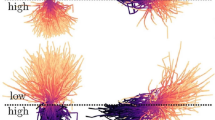Summary
-
1.
Amoeba proteus orients in directive illumination and is negative in strong light and probably positive in very weak light.
-
2.
Negative orientation is due to inhibition in the formation of pseudopods on the more highly illuminated surface; and this is due to increase in the elastic strength of the plasmagel on this side.
-
3.
If the luminous intensity is rapidly and greatly increased, all movement ceases, but if it is only slightly increased there is only a slight momentary retardation in the rate of streaming and this is confined to the tip of advancing pseudopods. Between these extremes there are innumerable types of responses depending upon the magnitude of increase in luminous intensity.
-
4.
Cessation in streaming is due to gelation produced by the light, resulting in increase in the thickness and the elastic strength of the plasmagel sheet at the tip of advancing pseudopods.
-
5.
The magnitude of gelation is correlated with the extent of increase in luminous intensity. This accounts in part for the relation between the nature of the response and the extent of increase in luminous intensity.
-
6.
The smaller the increase in luminous intensity, the less the gelation and the less the retardation in rate of flow. This relation continues theoretically until the increase in intensity is reduced to zero.
-
7.
There is no threshold and the “all or none law” does not apply.
Similar content being viewed by others
Literature cited
Arisz, W. H.: On the connection between stimulus and effect in photo-tropic curvatures of seedlings of Avena sativa. Proc. kon. Akad. Wetensch. Amsterd. 1911, 1022–1031.
Folger, H. T.: A quantitative study of reactions to light in Amoeba. J. of exper. Zool. 41, 261–291 (1925).
—: The effects of mechanical shock on locomotion in Amoeba proteus. J. Morph. a. Physiol. 42, 359–370 (1926).
—: The relation between the responses by Amoeba to mechanical shock and to sudden illumination. Biol. Bull. Mar. biol. Labor. Wood's Hole 53, 405–412 (1927).
Luce, R. H.: Orientation to the electric current and to light in Amoeba Anat. Eec. 32, 55 (1926).
Mast, S. O.: Mechanics of locomotion in Amoeba. Proc. nat. Acad. Sci. U. S. 9, 258–261 (1923).
—: Structure, movement, locomotion and stimulation in Amoeba. J. Morph. a. Physiol. 41, 247–425 (1926).
—: Response in Amoeba to localized photic stimulation. Anat. Rec. 47, 283 (1930).
Schaeffer, A. A.: On the behavior of Amoeba toward fragments of glass and carbon and other indigestible substances and toward some very soluble substances. Biol. Bull. Mar. biol. Labor. Wood's Hole 31, 303–328 (1916).
Author information
Authors and Affiliations
Additional information
I am indebted to Dr. H. R. Hulpieu for assistance in the observations on light and to the Bache Fund for financial aid.
Rights and permissions
About this article
Cite this article
Mast, S.O. The nature of response to light in Amoeba proteus (Leidy). Z. f. vergl. Physiologie 15, 139–147 (1931). https://doi.org/10.1007/BF00338922
Received:
Issue Date:
DOI: https://doi.org/10.1007/BF00338922




